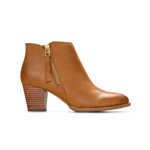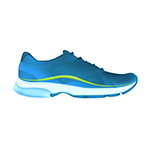
How To Fix Flat Feet: 8 Practical Steps

Flat feet, or pes planus, is a common issue that affects up to 20% of the adult population. When people discover they have flat feet, they often view it as a medical issue that—like many other health concerns—can be corrected with professional care.
While pes planus is a legitimate medical issue with various treatment options, there’s no overall consensus about how to fix flat feet. For many people living with flat feet, their collapsed arches give them few issues and are rarely a cause for concern. For many others, however, pes planus causes severe pain, incites inflammation, and can even restrict their mobility.
From first learning how to tell if you have flat feet to improving your health and selecting proper footwear, this guide will lay out 8 steps you can take to mitigate the effects of flat feet and correct your fallen arches.
#1: Check For Flat Feet
Before determining how to correct flat feet, you must first make sure that you have a flat arch problem to begin with. The kinds of bodily aches associated with pes planus—such as pain in your ankles, legs, and lower back—can stem from a variety of sources.
Luckily, you can easily and relatively accurately assess your arches without the need for special equipment or medical expertise. There are two standard at-home tests most people can conduct to assess if their feet have a normal arch or fallen arch:
- The Standing Test – Stand upright next to a mirror and observe the sides of your feet. There should be obvious and noticeable arches rising along their interior edges. If you feel like they’re missing, pes planus could be at play.
- The Wet Foot Test – Wet the bottom of your feet then stand upright on a surface that will easily show their print, such as dry concrete or a piece of paper. If you see the entire outline of your foot, it means the bottoms are flat. If the interior sides are missing, however, it’s a solid indication that your arches are intact.
Note: Consulting a doctor is important for all health issues and these tests are only to get a rudimentary idea of whether or not you have flat feet. They’re not meant to replace an actual medical assessment.
#2: Gauge the Severity of Your Pes Planus
If home tests lead you to believe you have flat feet, the next step is to consider how severe the condition is. Some doctors say up to 90% of flat-footed individuals are asymptomatic. For many, however, pes planus can cause severe pain, lower their quality of life, and even lead to further medical issues.
You’re likely not researching how to help flat feet if they’re not causing you any issues. Thus, if you’re experiencing any of the following symptoms, you may want to continue seeking help for your condition:
- Pain, particularly in the feet, ankles, legs, and lower back
- Involuntary and painful muscle spasms
- Trouble walking
- Swelling and inflammation of the arches and surrounding area
#3: Consult With a Medical Professional
If your pain is severe and persistent, you’ll likely want to consult a podiatrist for a professional opinion on your condition. While many cases of pes planus can be treated with basic measures—such as exercise and proper footwear—severe issues may require more active medical intervention.
Seeing a podiatrist can also help you uncover the root causes of your pes planus and put you on the path to correcting it. Oftentimes, they may suggest lifestyle changes that—on the surface—have nothing at all to do with your feet.
#4: Improve Your Overall Health
If you ask a podiatrist, “Can you fix flat feet?” they may say, “Yes, but it takes significant time and effort.” That’s because flat feet are often a reflection of your overall health. Ailing, weak ligaments/tendons and obesity are both primary causes of collapsed arches as we age.
So, to remedy your aching arches and mitigate your pes planus, consider:
- Weight loss – Obesity increases the strain on the ligaments, tendons, bones, and other parts of our feet. Over time, the strain from carrying around excess weight wears down on our arches, flattening them out and potentially causing bodily pain. Achieving a healthy weight reduces the pressure on your plantar (the ligaments connecting your heel to the front of your foot), which can significantly decrease the pain associated with pes planus.
- Exercise – Regardless of your current weight, increased physical activity can do wonders for your body. In one study, obese individuals with flat arches significantly ramped up the amount of exercise in their daily routines. After just 12 short weeks, their foot shape had already begun shifting, and their arches were returning to a normal, healthy depth.
- Stretching – Another common cause of flat feet is a shortened Achilles tendon. Regular stretching and regular foot health exercises have the potential to alleviate discomfort and lengthen the tendon. Additionally, stretching can help relieve pain in various other parts of your body, so try wiggling those toes, rotating your ankles, and limbering up your legs next time you experience a flare-up.
#5: Purchase Orthotics
While exercising and living a healthy lifestyle can help correct your flat feet in the long term, most people suffering from pain require immediate solutions. One option you can try that doesn’t require surgical correction is investing in supportive shoes with high-quality orthotic inserts. Properly fitting orthotics can make a world of difference, so make sure you find something that matches your foot shape and size.
Orthotic insoles won’t help you regrow your arches. They can, however, reduce the stress on your heel bone, ankle, and ligaments at the bottom of your feet. Less impact in this area means less energy radiating throughout your body and, ultimately, less pain. Orthotic insoles work because they:
- Enhance your foot’s alignment
- Improve your overall balance
- Absorb the shock from your feet repeatedly hitting the ground
- Generally make your shoes more comfortable to wear
#6: Wear Proper Shoes
The reality is that the majority of us aren’t wearing the correct shoes to aid our feet or the rest of our bodies. One study found that around 70% of people aren’t even wearing the right size, let alone finding footwear that offers the proper support our arches need.
If you are curious, “What are the best shoes for flat feet?”, it’s important to first note that proper shoes with built-in orthotics offer the same benefits as using insoles.
For flat-footed individuals hoping to reinvigorate their lives by walking, we suggest the Walk Max Lace Up Sneaker, which is known for its feather light design and durable, water-repellent construction.
If you’re looking for an everyday shoe that looks fantastic while making your feet feel the same way, try the Kearny Platform Lace Up Sneaker. With a plush, cushioned interior and deep heel cup, they’re excellent at absorbing shock from repeated steps while providing unparalleled flexibility and range of motion.
Finally, if you want something that’s supremely fashionable and foot-friendly, there’s the Winny Sneaker. While the bottom may look flat (it’s undercover as a casual, street-style shoe), the interior cushioning firmly hugs the arches of your feet, correcting your alignment and improving your pes planus symptoms.
#7: Consider Corrective Surgery
Flat foot surgery is a rare but sometimes necessary treatment option for correcting extremely severe cases of pes planus. Corrective surgery is generally seen as a last resort when lifestyle changes, better footwear, and other treatments simply aren’t working. Usually, it’s only recommended in cases with:
- Severe injuries
- Torn tendons
- Bone deformities
Flat foot reconstruction surgery, as the operation is often called, is actually a combination of various different surgical techniques. While operating to correct an individual’s pes planus, a doctor may:
- Fuse several bones together to prevent them from rubbing up against each other and causing pain while you walk
- Graft bones and transfer tendons to new positions to recreate collapsed arches
- Perfect a dorsal opening wedge osteotomy, a treatment that divides the medial cuneiform bone in the middle of your foot and grafts a wedge in the center to lengthen it, in turn leading to deeper arches
Again, surgery is only necessary in a small percentage of cases. If your flat feet are severe and other approaches aren’t working, your doctor will inform you if they believe you’re a viable candidate for surgery.
#8: Maintain Healthy Habits
Can you correct flat feet? As you now know, with lifestyle and footwear changes, you can help restore your fallen arches and reduce your pes planus symptoms. To continue reaping the benefits, however, you have to maintain your new healthy habits.
So, after working so hard to fix your flat feet, keep them feeling fantastic by routinely:
- Exercising and eating right to maintain a healthy weight
- Wearing quality, supportive shoes and orthotics no matter the weather or occasion
- Checking in with your doctor to ensure your flat feet and their symptoms aren’t worsening
Rock Vionics to Keep Pes Planus Symptoms at Bay
Supportive footwear is the easiest and, often, most essential step you can take to help correct your pes planus and reduce its symptoms. That’s why you want a quality pair of Vionic shoes as a go-to everyday pair.
For over 30 years, our team at Vionic has been perfecting our arch support footwear and insoles for women’s shoes with the goal of helping individuals like you stand, walk, and live more comfortably. That’s why every model we produce—from our performance footwear to flat shoes for women—is crafted to optimize stability, foot arch support, cushioning, and flexibility.
Try a pair—any pair—and discover the difference proper support can make for your flat feet.
Sources:
Cleveland Clinic. Flat Feet. https://my.clevelandclinic.org/
National Library of Medicine. Pes Planus. https://www.ncbi.nlm.nih.gov/
Columbia Broadcasting System. Flat Feet Are More Common Than You Might Think. https://www.cbsnews.com/
Mayo Clinic. Flatfeet. https://www.mayoclinic.org/
National Library of Medicine. Incorrectly fitted footwear, foot pain and foot disorders: a systematic search and narrative review of the literature. https://www.ncbi.nlm.nih.gov/Penn Medicine. Flat Foot and High Arches Treatment. https://www.pennmedicine.org/









